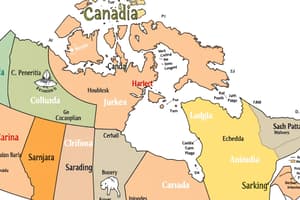Podcast
Questions and Answers
What did the Balfour Report of 1926 confirm about Canada’s status within the British Empire?
What did the Balfour Report of 1926 confirm about Canada’s status within the British Empire?
- Canada required British approval for all decisions.
- Canada was an equal partner within the British Commonwealth. (correct)
- Canada was still a subordinate colony.
- Canada had no autonomy in its governance.
Which act granted Canada full control over its own laws and legislation?
Which act granted Canada full control over its own laws and legislation?
- The Canadian Charter of Rights and Freedoms
- The Statute of Westminster (correct)
- The Balfour Report
- The Constitution Act of 1982
What significant change occurred with the Constitution Act of 1982?
What significant change occurred with the Constitution Act of 1982?
- Canada’s constitution could now be changed by the British Parliament.
- The Canadian Charter of Rights and Freedoms was repealed.
- Legal independence was granted to provinces only.
- Canada gained independent control over its constitution. (correct)
How did the Battle of Vimy Ridge contribute to Canada’s national identity?
How did the Battle of Vimy Ridge contribute to Canada’s national identity?
What distinguished the Constitution Act of 1982 from previous constitutional arrangements for Canada?
What distinguished the Constitution Act of 1982 from previous constitutional arrangements for Canada?
What significant event during World War I contributed to Canada's national identity?
What significant event during World War I contributed to Canada's national identity?
Which act united the provinces of Ontario, Quebec, New Brunswick, and Nova Scotia into the Dominion of Canada?
Which act united the provinces of Ontario, Quebec, New Brunswick, and Nova Scotia into the Dominion of Canada?
How did Canada’s participation in World War I impact its autonomy?
How did Canada’s participation in World War I impact its autonomy?
What was a significant political change for Canada after World War I?
What was a significant political change for Canada after World War I?
What foundation did Confederation lay for Canada?
What foundation did Confederation lay for Canada?
What role did the Battle of Vimy Ridge play in Canadian history?
What role did the Battle of Vimy Ridge play in Canadian history?
Which event marked Canada's growing recognition on the international stage?
Which event marked Canada's growing recognition on the international stage?
During which event did Canadian troops fight under their own command for the first time?
During which event did Canadian troops fight under their own command for the first time?
Flashcards
Confederation (1867)
Confederation (1867)
The formal union of Ontario, Quebec, New Brunswick, and Nova Scotia into the Dominion of Canada on July 1, 1867, which marked the beginning of Canada's journey to autonomy. Although Canada was granted self-governance in many domestic areas. It still remained under British control in key areas such as foreign policy and constitutional changes. It established Canada's own government and a sense of national unity.
Canada in World War I
Canada in World War I
Canada's participation in World War I was a significant step towards autonomy. It joined the war effort alongside Britain, demonstrating its growing independence and solidifying a national identity.
Battle of Vimy Ridge (1917)
Battle of Vimy Ridge (1917)
A key battle in World War I where Canadian troops played a crucial role under Canadian command, capturing a vital ridge from German forces. Vimy Ridge was a defining victory that solidified Canada's military capacity and a sense of national pride.
Paris Peace Conference (1919)
Paris Peace Conference (1919)
Signup and view all the flashcards
Patriation of the Constitution (1982)
Patriation of the Constitution (1982)
Signup and view all the flashcards
Balfour Report
Balfour Report
Signup and view all the flashcards
Statute of Westminster
Statute of Westminster
Signup and view all the flashcards
Patriation of the Constitution
Patriation of the Constitution
Signup and view all the flashcards
Canadian Charter of Rights and Freedoms
Canadian Charter of Rights and Freedoms
Signup and view all the flashcards
Decentralization of Power
Decentralization of Power
Signup and view all the flashcards
Study Notes
Canada's Path to Autonomy
- Confederation (1867): July 1, 1867, Ontario, Quebec, New Brunswick, and Nova Scotia united as the Dominion of Canada under the British North America Act (now the Constitution Act, 1867). Canada retained self-governance in domestic matters but remained under British control for foreign policy and constitutional changes. This laid the groundwork for future independence.
World War I and Vimy Ridge
- Canada's Involvement: Canada joined WWI alongside Britain as a Dominion of the British Empire.
- Vimy Ridge (1917): A pivotal battle where Canadian troops successfully captured a crucial ridge from German forces. This victory significantly shaped Canadian national identity, showcasing Canadian military prowess and demonstrating a distinct national fighting force.
- Increased National Pride: The success fostered a strong sense of Canadian pride and a growing belief in Canada's independence from Britain.
Post-War Developments
- Paris Peace Conference (1919): Canada, for the first time, signed the Treaty of Versailles independently of Britain, recognizing Canada as a separate entity on the international stage.
- Balfour Report (1926): This report established dominions like Canada as equal partners within the British Commonwealth. Canada achieved self-governing status, able to make its own decisions without British interference.
- Statute of Westminster (1931): This act granted Canada full control over its laws and legislation, furthering Canada's independence.
Final Steps to Independence
- Consitution Act of 1982 (Patriation): This act transferred full control of Canada's Constitution to Canada itself. For the first time, Canada could alter its constitution without British approval. It also included the Canadian Charter of Rights and Freedoms.
Conclusion
- Vimy Ridge was a significant event, shaping national identity and contributing to Canada’s emergence as an independent nation. The Balfour Report, Statute of Westminster, and the patriation of the Constitution finalized Canada's legal and political separation from Britain.
Studying That Suits You
Use AI to generate personalized quizzes and flashcards to suit your learning preferences.




